Chess rules briefly. How the queen and king move in chess
Chess is played on a square board of eight rows (labeled 1 to 8) and eight columns (labeled A to H). The board consists of 64 usually black and white fields. Chess is played by two players, the pieces of the opponents are placed on opposite sides of the board. At the beginning, each player has 16 pieces from the bottom: 1 king, 1 queen, 2 bishops, 2 knights, 2 rooks and 8 pawns. The player who plays with white pieces starts the first move, making moves in turn, moving the pieces to free places or to those occupied by the opponent, capturing his piece, thereby removing it from the playing field. The goal of the game is to checkmate the opponent's king (put MAT). There are several situations of interaction with the king - SHOW, MAT and PAT.
SHAH- this is a situation when the king is under attack by the opponent's pieces, but can escape from the attack to another field or cover the king from the opponent's attack with his piece.
MAT- this is a situation when the king does not have the opportunity to get away from the SHAH. Such a move in the game leads to its end.
PAT- this is a situation when the king cannot make a move on the next move, that is, move to a field that is not attacked by the enemy. This situation in the game leads to a draw, such a rule finally came into force in the 19th century.
All pieces move differently, with the exception of the knight, all other pieces cannot step over pieces, and pieces cannot stand on the squares occupied by pieces of their color. When making a move, as a rule, the pieces should be positioned in such a way as to threaten the opponent's pieces and protect your pieces, as well as control important fields for you.
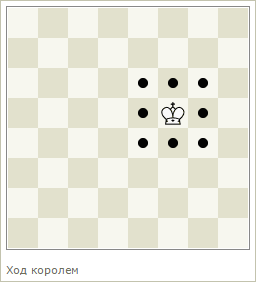 |
King is the most important piece on the field, at the same time the weakest one, he can only move one square in any direction, but not on those squares on which he will be under SHAH. |
 |
Queen the strongest piece on the playing field, it can move in any direction and at any distance, but cannot step over the pieces. When capturing an opponent's piece, the queen's move ends on it and takes its place. |
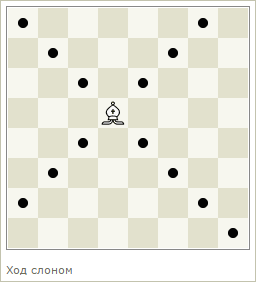 |
Elephant can move to any number of fields only along the diagonal. The peculiarity of this figure, each of them is controlled by its own color of the fields (black or white) |
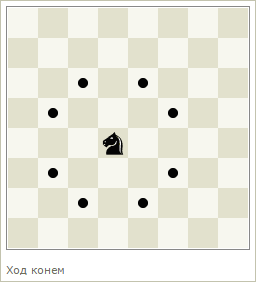 |
Horse a special piece that makes a move not by analogy with other pieces. The knight moves according to the principle of the letter "G" and always moves from a white field to a black one. This is the only piece in chess that can jump over an opponent's piece or a piece of its own color. |
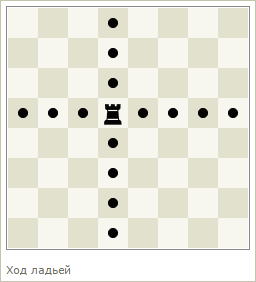 |
Rook can move to any number of fields horizontally and vertically, they are especially strong when working in pairs |
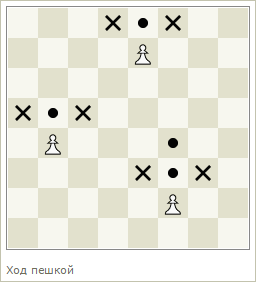 |
Pawn the simplest piece at the same time and the most versatile, having reached the opposite side, it can turn into any piece except the king. A pawn moves only one space forward vertically, except for the first pawn move, it can move two spaces forward. A pawn can capture an opponent only diagonally one square to the left or right |
There are also special moves in chess, such as Capture on the way and Castling.
Taking on the way this is another rule associated with pawns, namely the capture of an opponent's pawn that has moved two squares forward. But under attack is not the square on which the opponent's pawn made a move, but the one that was crossed by it. The pawn completes its move exactly on this crossed square, as if the opponent's pawn moved one square forward.
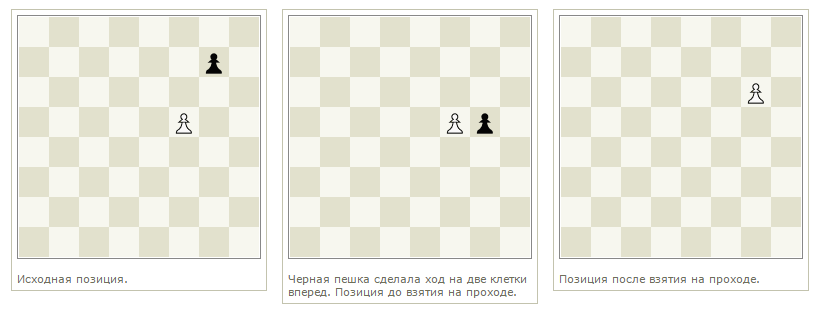
Castling one more special rule. This move can do two important things. This is to secure the king and the second to get the rook out of the corner. The action consists in moving the king towards the rook of its color (regardless of which, it is possible to the left and right) two squares and then moving the rook to the adjacent square from the king on the other side. Castling is also possible only if the following rules are observed:
- These should be the first moves of the king and rook pieces;
- The fields between the figures must be free (empty);
- The king should not be under the SHOW, also in the square where the move is made.
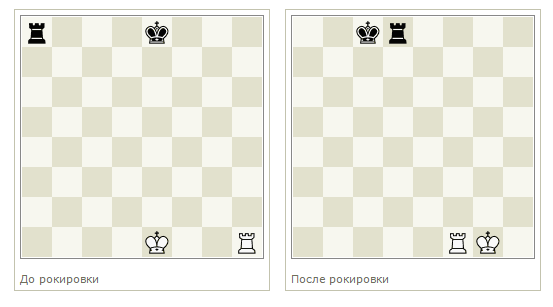
It also happens in Chess that there is no winner, that is, a draw. There are several rules by which the game ends in a draw:
- Not enough pieces on the board to checkmate the opponent
- PAT has already been described above, and also when a player with the right to move cannot use it
- By mutual agreement, the players can agree on a draw and end the game
- Also, a draw is declared when a player makes three moves repeating the same positions, not necessarily three moves in a row.
- With fifty moves during which they did not move a pawn more than once or did not capture any piece
Article 3: PIECE MOVES
3.1. It is not allowed to move a piece on a square occupied by a piece of the same color. If a piece moves to a square occupied by an opponent's piece, the latter is taken and removed from chessboard, as part of the same move. A piece is said to attack an opponent's piece if, in accordance with Articles 3.2 to 3.8, that piece can capture an opponent's piece on that square.
A piece is considered to attack a square even if it cannot go to that square, since in this case the king of the same color will remain or be under attack.
3.2. The bishop can move to any square along the diagonal it is on.
3.3. The rook can move to any square along the file or rank on which it stands.
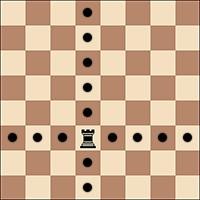
3.4. The queen can move to any square vertically, horizontally or diagonally on which she stands.
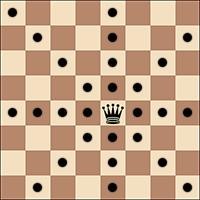
3.5 When making these moves, the bishop, rook or queen cannot cross the squares occupied by other pieces.
3.6. The knight may move to one of the squares closest to the one it is on, but not on the same file, rank or diagonal.
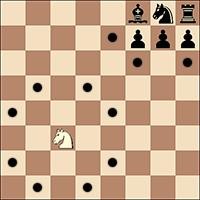
3.7. a) a pawn may advance to a square directly in front of it on the same file, provided that this square is not occupied; or
b) on its initial move, the pawn may move as described in Article 3.7a, or it may advance two squares along the same file, provided that both of these squares are unoccupied; or
c) a pawn can move to a square occupied by an opponent's piece located diagonally in front of it on an adjacent file, capturing this piece.
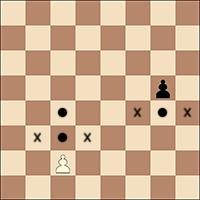
d) A pawn occupying a square on the same rank and on an adjacent file with an opponent's pawn that has just advanced two squares one move from its original position may capture that advanced opponent's pawn as if its last move had been only one field. This capture is only allowed on the move following this advance and is called an en passant capture.
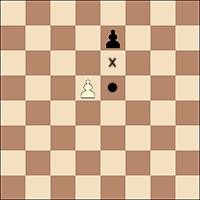
e) When a player, on his move, advances a pawn to the rank furthest from its original position, he must exchange that pawn within the same move for a new queen, rook, bishop or knight of the same color on the intended promotion square. The player's choice is not limited to pieces that have already been taken before. This replacement of a pawn by another piece is called a "promotion" and the action of the new piece begins immediately.
3.8. There are two various ways make a move with the king:
a) go to any adjacent field,
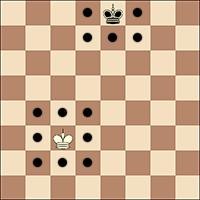
b) castling. This movement of the king and one of the rooks of the same color along the player's first rank, counted as one move of the king, is performed as follows: the king moves from its initial square two squares towards the rook on the initial square, then this rook moves to the field that the king has just crossed.
Bottom left - the position before White's castling to the kingside and Black's castling to the queenside. Bottom right - the position after White's castling to the kingside and Black's castling to the queenside.
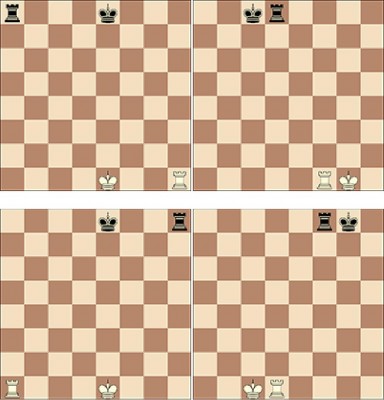
Top left - the position before White's castling to the queenside and Black's castling to the kingside.
At the top right, the position after White's castling to the queenside and Black's castling to the kingside.
(1) The right to castling is lost:
a) if the king has already moved,
b) with the rook that has already moved.
(2) Castling is temporarily not possible:
a) if the square on which the king stands, or the square that he must cross, or the square that he must occupy, is attacked by one or more opponent's pieces;
b) if there is a piece between the king and the rook to be castled.
3.9. The king is said to be "in check" if it is attacked by one or more of the opponent's pieces, even if such pieces cannot move towards the square occupied by the king, since in this case they will leave in check or put their own king in check. None of the pieces can make a move that puts his king in check or leaves his king in check.
3.10. a) A move is considered legal by the Rules when all the relevant requirements of Articles 3.1 to 3.9 are fully met.
b) A move is considered illegal by the Rules when it does not meet the relevant requirements of Articles 3.1 to 3.9.
c) A position is considered invalid if it cannot be obtained by any series of moves permitted by the Rules.
IN chess game 6 types of figures participate - king, queen, rook, knight, bishop, pawn. At the beginning of the game, each player has 16 pieces at his disposal: king, queen, two rooks, two bishops, two knights, eight pawns. There are 32 pieces on the board in total.
The starting position of the shapes looks like this:
Pawn
The pawn, the only piece that can only move forward, cannot move backward. The face value of a pawn is 1 point.
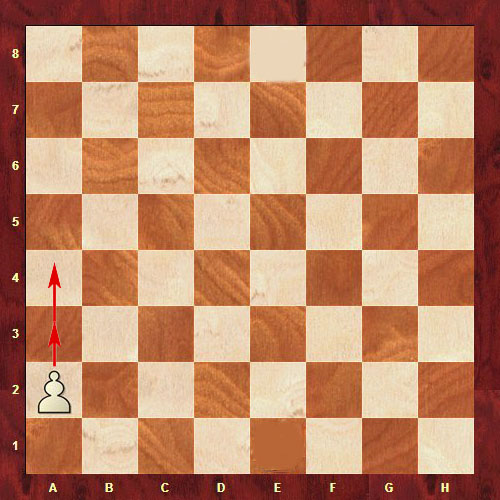
In the initial position (white - on the 2nd horizontal, black - on the 7th) the player can move the pawn one or two squares forward. After the first move, the pawn can only be moved forward one square at a time. A pawn can beat the opponent's pieces one space forward diagonally to the right and left. . A pawn captures pieces according to one rule, but moves differently. This is what distinguishes her from other figures.
There are two interesting rules in chess associated with the pawn. . The essence of the first rule is as follows. pawn d reaches the last rank (8th for white x and 1st for black) and turns into any figure, except for the king. Such a transformation is one move, and the next move goes to the opponent.
The second rule is son-in-law on the aisle. On its move, a pawn can capture an opponent's pawn if it has crossed a beaten square.
![]()
On fig. 3 white pawn moved two squares forward. The black pawn can beat the white one and stand on the beaten square, and not on the square where the white pawn has landed, as happens with ordinary captures . Capturing on the aisle is possible only during the next move, after a move this right is lost.
Horse
Horse walks along an unusual trajectory resembling a letter"G" - moves 2 cells forward and one cell to the side . Of all the pieces, only the knight can jump over its own and other people's pieces. The knight can attack any enemy piece, being out of reach for them. When struck, the knight takes the place of the captured figure. The nominal value of a knight is 3 points. Located in the center of the board, he has 8 moves available, while in the corner box he has only 2.
In real life"to make a knight's move" - means to perform some unusual or cunning step.
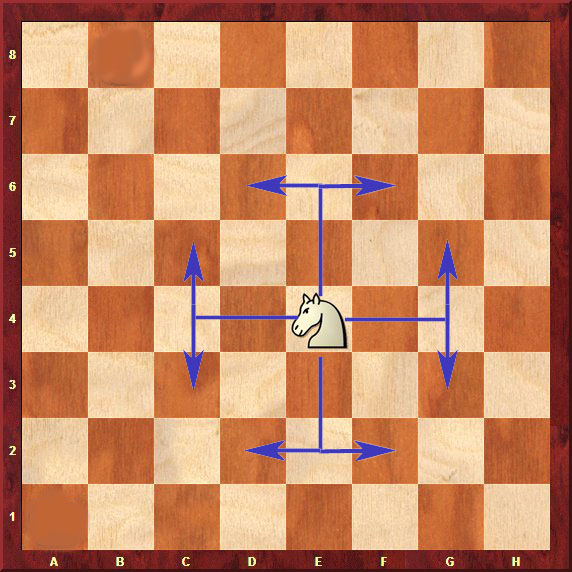
Elephant
The bishop is a strong, long-range piece. The Bishop has a face value of 3 points and is roughly equal in strength to a Knight. This comparison is somewhat arbitrary, since in an open position the bishop can be stronger than the knight, and in a closed position the knight is often stronger than the bishop. The knight and the bishop are referred to as "light pieces" in chess.
The elephant walks and strikes in all directions diagonally to any number of squares, as shown in the figure. An elephant that walks on white squares is called light-squared, and on black - black-squared.
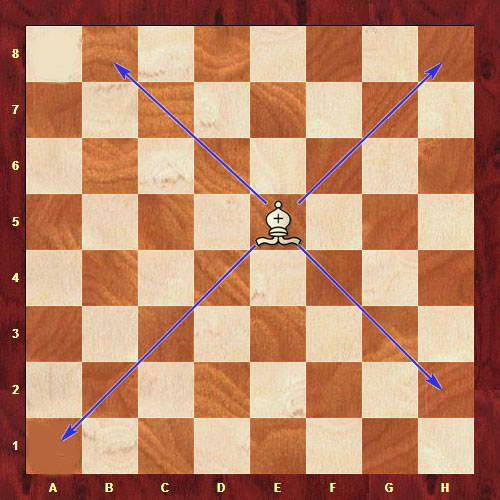
Rook
Rook , like the queen, are considered heavy pieces. Its face value is 5 points. The rook moves and attacks vertically and horizontally on any number of squares.
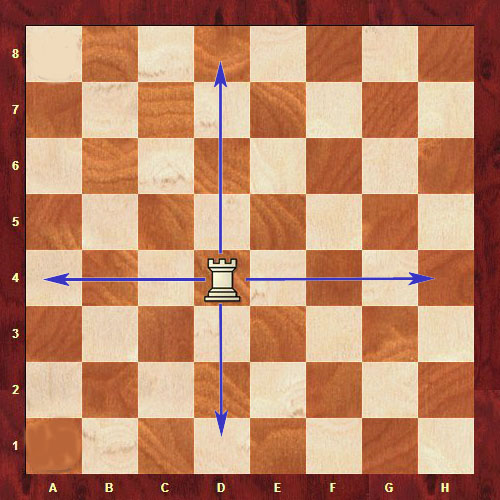
A specific move in a chess game is castling. Castling is correctly performed as follows - the king is moved 2 squares to the rook and the rook is moved behind the king. Castling can be done under the following conditions:
to the king and the rook with which castling occurs, before that, no moves were made in the game;
on the horizontal m there are no other pieces between the king and the rook;
to the king not is under attack by an opponent's piece;
on the field through which the king moves and the field on which he does not stand are under attack enemy pieces.
Long castling is performed towards the queenside, short - towards the king's side.
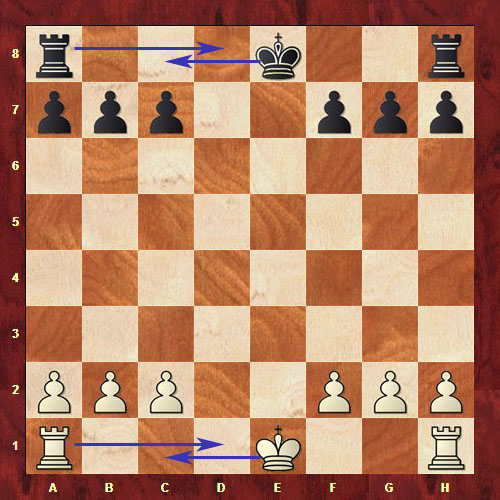
You can't move the rook first. There is a rule in chess: take it - move. If you first move the rook to the king, the opponent has the right to demand that the move be considered completed, and castling will not take place. Castling is the only move in chess where two pieces play the same move.
Queen
Queen - the strongest piece in chess, with a face value of 10 points. The queen moves in all directions vertically, horizontally and diagonally to any number of cells on the board. The queen is an important piece. He is strong and mobile, effective in attack and defense. The queen must be protected from the blows of the opponent's pieces. Losing a queen or exchanging it for a piece of less value leaves little chance of winning.
Equally, a queen can be exchanged for a queen, two rooks, or three minor enemy pieces. There are cases when an experienced chess player deliberately gives up the queen to achieve a certain goal in the game. It's called "sacrifice". Novice amateurs should remember that the queen must be kept and used as the strongest piece.
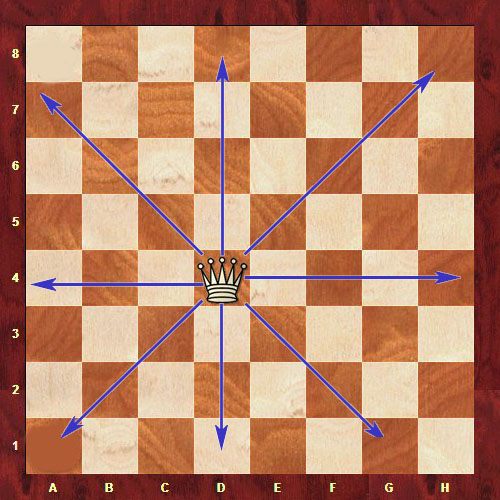
King
The king is the most important piece in chess and has no face value. The game is lost, when the king dies, he will get a checkmate. The king cannot be kept under attack by enemy pieces. He needs constant protection. Like the queen, the king moves and strikes vertically, horizontally and diagonally, but only one cell in any direction. Located in the middle of the board, the king keeps under attack 8 fields.
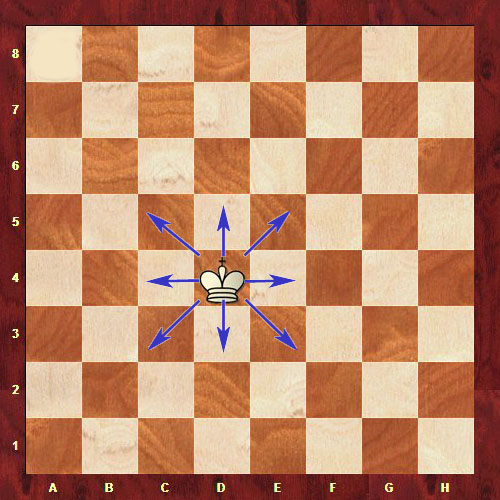
At the end of the game, when there are an order of magnitude fewer pieces on the board, the strength of the king becomes approximately equal to the strength of a minor piece.
A check is a position where the king is under attack by an opponent's piece. The king cannot be left in check. You need to go to another field, defend yourself with your piece, or simply beat the opponent's piece that declared check.
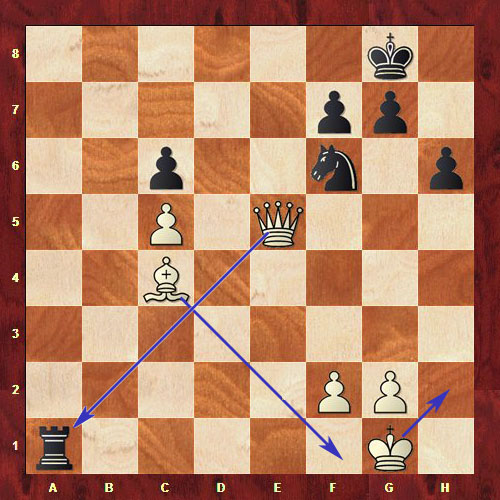
On fig. 10 the white king can get away from the check, the bishop can cover the king, the queen can beat the black rook.
The game ends when the king gets checkmate. This means that the king is under attack (check) and he has nowhere to go - the free squares are under attack by the opponent's pieces.

A curious situation in the game - stalemate. The king is not in check, but he has nowhere to move - all free squares are under attack by the opponent's pieces. Other pieces also have no moves.
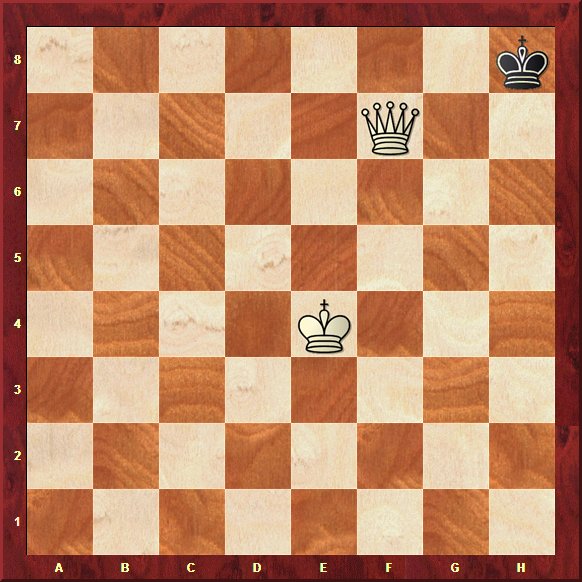
In this case, the game ends in a draw.
According to the accepted scoring system, there are 1 point for a win, 0.5 points for a draw, and 0 points for a loss.
Some figures have a double name. Before the revolution, the bishop was called an officer, the rook was called the round, the queen was called the queen. Among chess players, these names are not widespread, sometimes they are used by amateurs.
Lesson 5
Lesson 5 Queen, king.
So, for a snack we have the most interesting.
.
The queen is the most powerful chess piece. The nominal value is 10 points.
As Cardinal Richelieu said, playing chess with D'Artagnan: "This is the queen, she moves as she pleases ...". The cardinal was essentially right, except that "queen" is not the correct name. This figure is called "Queen". But that's what the storyline demanded...
The queen moves in all directions vertically and diagonally for any distance. That is, he has the capabilities of a rook and a bishop at the same time. Can NOT jump over pieces. Schematically indicated in the diagram below.
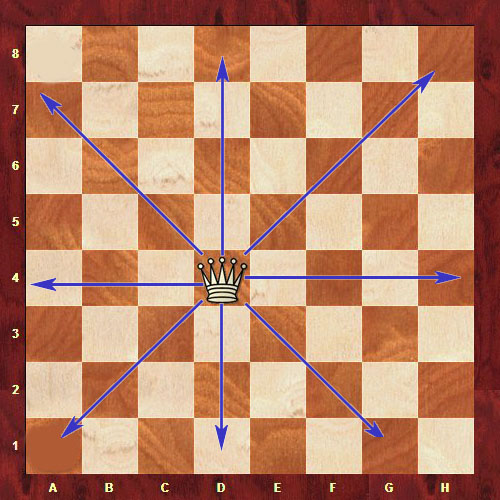
The importance of the queen is hard to overestimate. He is very effective both in defense and attack, very mobile and strong. The only negative that is associated with the queen is that it must be protected from attacks. For example, in the position in the following diagram, the white queen can attack one of several black pieces: a knight, a bishop, and a pawn. However, all these pieces are protected by the black queen. If the white queen decides to hit either of them, the black queen's next move will hit the white one. And any such exchange will be disadvantageous for White, because he will lose his strongest piece, and take a piece of lesser value for it.
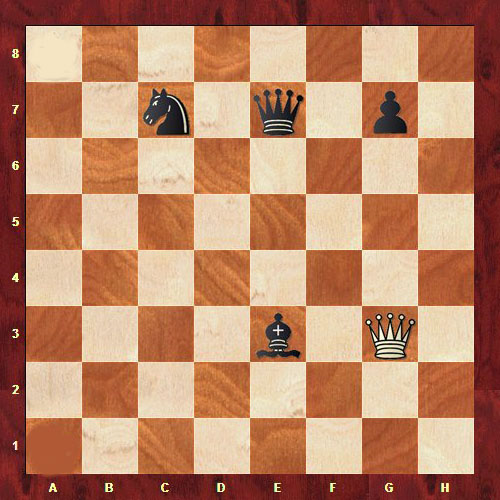
Swapping a queen, say, for a knight or bishop is almost always not profitable. Equally, the queen can be exchanged only for the opponent's queen, or for several pieces at once. Although there are times when chess players give away the queen on purpose to achieve some task. But more on that later. For now, you need to realize that the queen should be protected and used rationally as your strongest weapon.
King.
King is the most important figure. It has no face value. It cannot be exchanged, kept under attack by the opponent's pieces. It requires constant protection. But this is not because the king is too weak as a piece, but because if he dies, then the game is lost for the player.
On the other hand, the king can also move and capture the opponent's pieces. At the end of the game, when there are an order of magnitude fewer pieces on the board, and there are not so many direct threats to the king, its strength is estimated approximately as the strength of a minor piece (knight or bishop).
The king, like the queen, walks and strikes in all directions vertically and diagonally, but only on one cell.
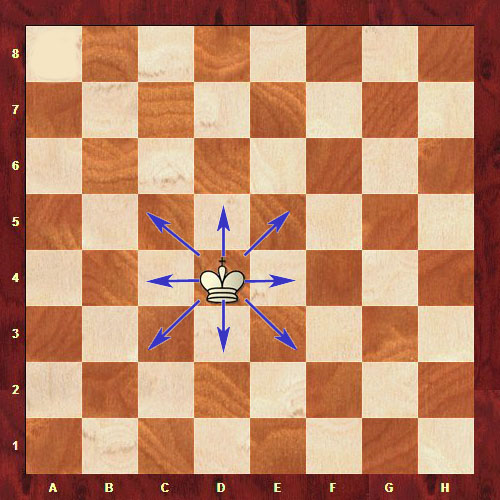
That is, being in the middle of the board, the king breaks through 8 squares.
Now you know how chess pieces move and strike. To remember each, you need to practice. In order for this practice to be quick and fun and at the same time effective, I suggest playing the so-called "Chess Labyrinth":
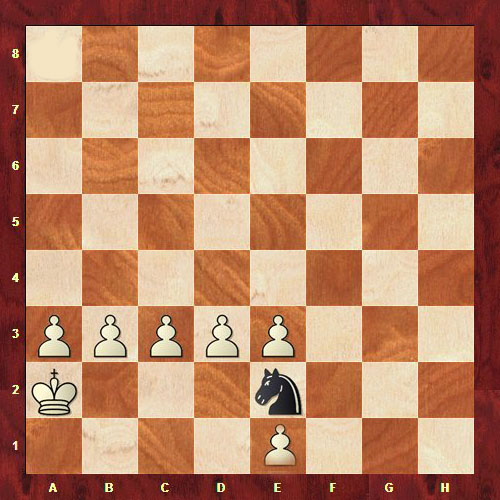
The scenario is as follows: the white king is you. Pawns are the walls of your house. They cannot be moved. The black horse is a guest to be greeted. In other words, it is necessary to reach the knight with the king. How the king walks, I think you remember.
In essence, everything is simple, the king reaches the knight one square at a time, but not quite ... You have a lot of furniture at home that prevents you from reaching the guest. For example, like this:
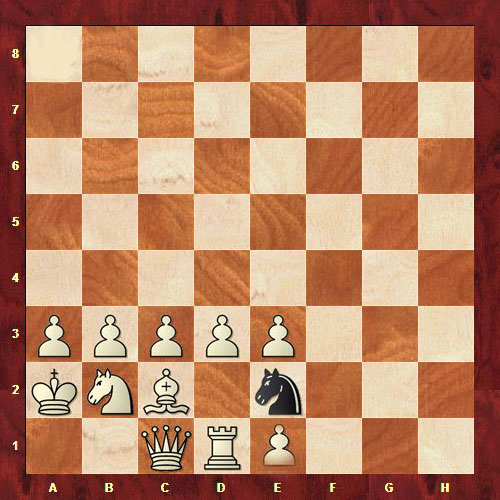
Furniture must be moved to clear a path. Thanks to this game, you can quickly remember how each piece of this "furniture" moves :)
Make it difficult for yourself until there is very little space left in your house. For example, like this:
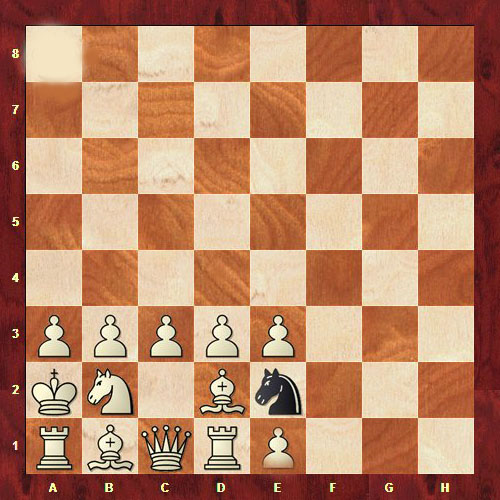
1-2 hours a day, approximately 1-2 days depending on your personal characteristics. I'm sure you won't forget how the pieces move after that.
Now that we know how the pieces move, it would be great to determine what to do with them, that is, to find out the goal of the game. About this in next lesson.
You have probably heard that chess develops thinking, observation, the ability to assess the situation, otherwise you would not have opened this article. Sovsport. en I tried to summarize the rules of chess for beginners - if you have never played this game before, then it's time to learn. If you played a little and for a long time, then you can refresh your knowledge. If you want to teach your children, we will try to help.
THE LEGEND OF THE ORIGIN OF CHESS
If you are going to explain the rules of chess to children, then first try to captivate them with the legend of the origin of chess.
A long time ago, about two thousand years ago, when there were no iPads or even TVs, the despotic and frivolous Raja Bagram lived and ruled in India, who constantly entertained himself by fighting with his neighbors. And one of his close associates named Nazir decided to distract the ruler from the wars with a game that he invented, and at the same time show that the king means little without the support of his subordinates. In this game, on a 64-cell board, in addition to the king, infantry and cavalry, elephants and fortresses were placed and fought - everything is like in a real Bagram army, so he really liked the game. He asked Nazir what reward he wanted for his invention.
“Put 1 grain of wheat on the first cell of the board, 2 on the second, twice as many again on the third, that is, 4, on the fourth, 8, and so on, until you fill all 64 cells,” the sage answered.
“You don’t think well of my generosity! Is this a worthy reward? All right, you'll get your sack of wheat!" Bagram waved his hand.
But when the court mathematicians calculated how many grains Bagram should give to Nazir, they got a huge amount - 18,446,744,073,709,551,615! This is more than grains of sand in the largest desert of our Earth, the Sahara! After that, the raja realized how smart Nazir was, and even more respected the game that he had come up with.
PURPOSE OF THE GAME
The rules of the game of chess were refined for many centuries, but in their classical version they were established several centuries ago. The game is played on a board consisting of 64 alternating black and white cells. You need to start arranging the pieces when the board lying in front of you in the near right corner has a white cell.
There are 16 pieces in your army - a king, a queen (queen), 2 knights, 2 bishops, 2 rooks and 8 pawns. In the row closest to you, rooks are placed along the edges, then, closer to the center, horses, then bishops. The remaining two cells are occupied by the king and queen, and it is easy to remember their location by the phrase "the queen loves her color." That is, the white queen is on a white square (and the white king is on a black one), and the black queen is on a black one, leaving a white square for the black king. The second row from the players is entirely occupied by pawns.

White makes the first move. In one move, only one piece can be moved by any number of cells allowed for it. If your piece "lands" on the cell where the opponent's piece stands, then his piece "dies" and is removed from the board.
The goal of the game is to "capture" the other's king before the other's army "captures" yours. The situation when the opponent's king is attacked by any of your pieces, but can hide on an adjacent square or behind another piece, is called "check". And if he is under attack and there is nowhere for him to hide, it means you checkmate and win.
HOW CHESS PIECES WALK
To show how chess pieces move on the board, there is nothing better than to present this part of the rules of chess in pictures. But first you need to remember: according to the rules, if you took up any piece, then you must make a move to it.
King. Moves one square in any direction. An exception is castling (more on that below). You cannot lose the king, so the king can never move to the cell that is under attack by someone else's piece. If your opponent accidentally put the king on a square where he could not go, do not shout "Ha ha, I won!", but put his piece back and explain what he made a mistake.
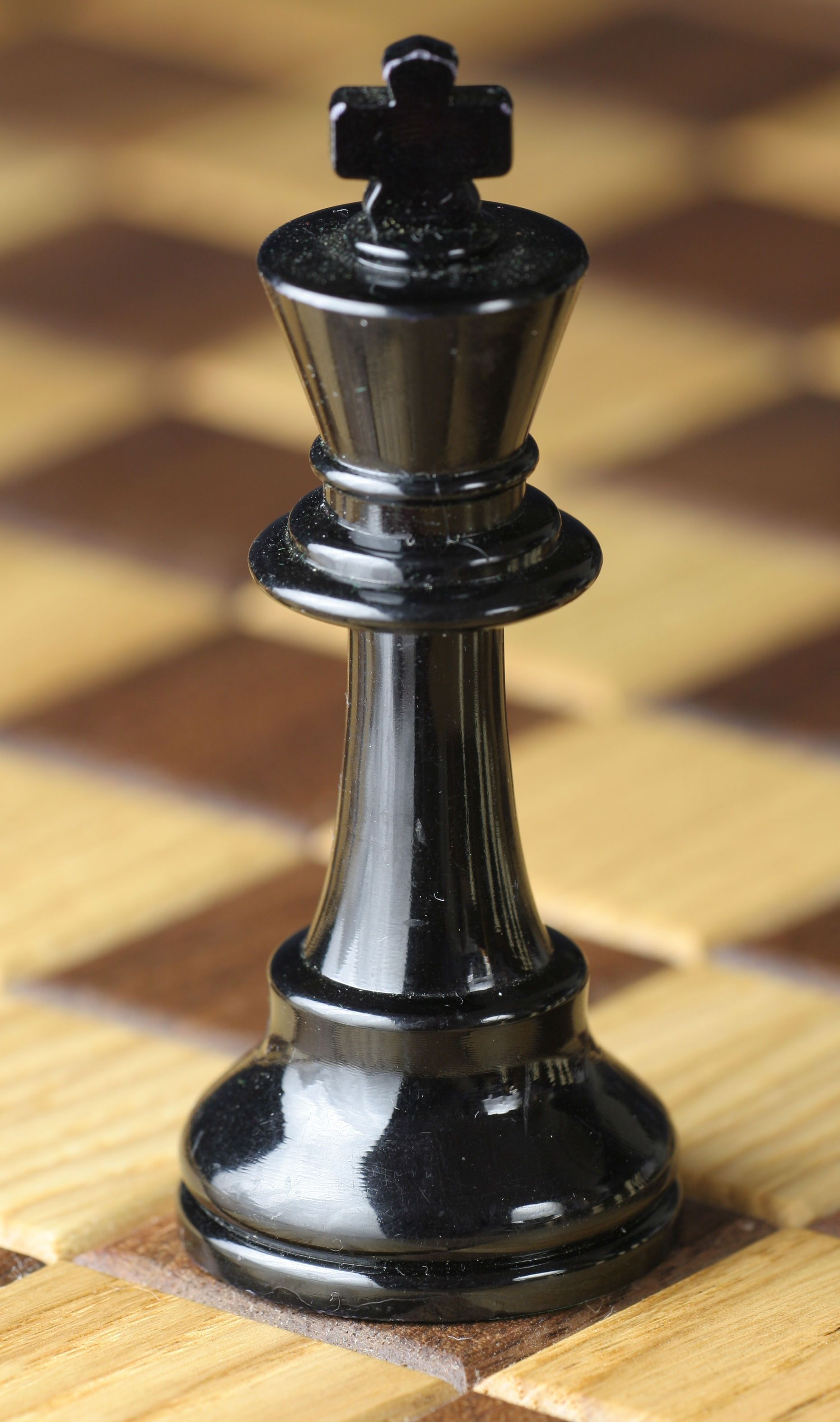
Queen. The strongest figure. Moves any number of cells in any direction.
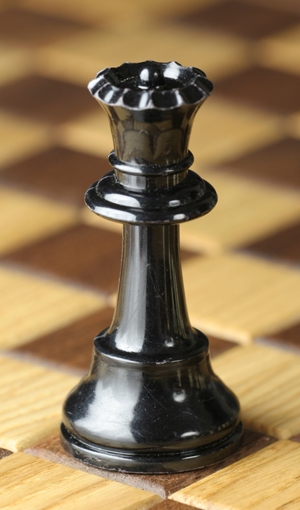
Elephant. Moves any number of cells along any diagonal. As you can see, one elephant starts the game on the cage white color(and he can never end up on black) and the other one starts on black (and never jumps over to white).
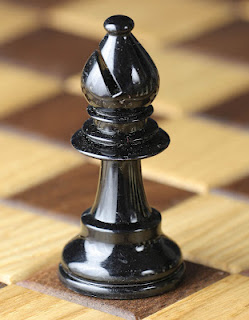
Horse. The most unusual figure moves with the letter “G”, that is, two cells in any direction, then makes a 90-degree turn in any direction and moves one more cell. At the same time, the horse is the only piece that can "jump" over others.
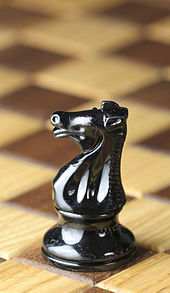
Rook. Moves in a straight line - that is, forward, backward or in any direction for any number of cells.
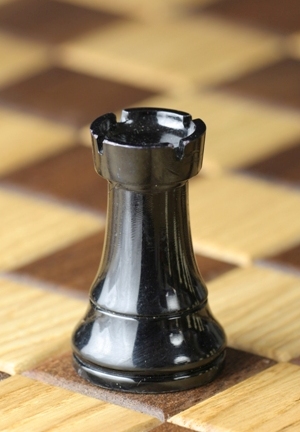
Pawn. The simplest soldiers in your army can only move forward. On their first move, they can step either one or two squares. But in the future they walk carefully - one cell and no more. But if someone else's piece is standing in front of them, then they cannot attack it. Why? Because pawns attack other people's pieces also with a one-cell step, but not directly, but diagonally!
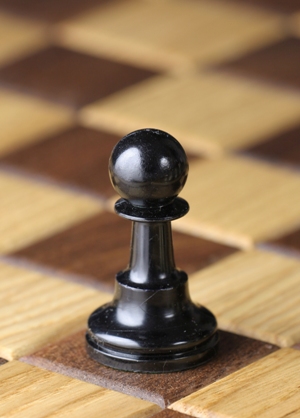
However, as often written in the rules of chess for children, the slow and clumsy pawn has a dream that she sometimes manages to fulfill. If it reaches the opposite edge of the board, it can turn into any other piece (except the king and itself, that is, a pawn). Usually a pawn is made into a queen, because, as you already know, this is the most powerful piece.
The so-called “capture on the aisle” is connected with the pawn, which we will discuss below.
SPECIAL MOVES
There are two special moves. Again, for clarity, we will explain these nuances of the rules of the game of chess in the pictures.
The first special move is called castling. If the king and rook have not yet moved since the beginning of the game and there are no other pieces between them, then they can castle. To do this, the king takes two steps towards the rook, and she "jumps" over him. At the same time, neither the cell on which the king stood, nor the cell that he crossed, nor the cell on which he stood, should be under attack by the opponent's pieces.
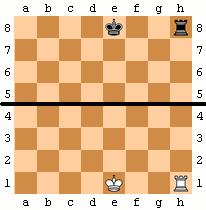
"En passant capture" refers to the pawn's first move, when it moved two squares at once. If a pawn - for example, white - stepped two squares and at the same time caught up with the opponent's black pawn, then the player with black pieces can next move his pawn to the square that the white pawn just jumped over and remove the frisky opponent from the board. But if he does not make this move right away, then in the future he can no longer claim to “eat” the white pawn.
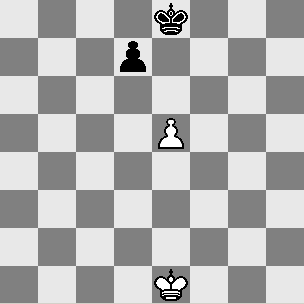
END GAME
As already noted, the game ends when the king of one of the chess players is under attack and cannot "escape" from him or defend himself with another piece. This is called "checkmate". The one who managed to drive someone else's king into such a trap is declared the winner. The party can also end in the victory of one of the participants, if the other himself declares his surrender.
If the king of one of the participants in the game is not under attack, but this participant cannot move any of the pieces, then this situation is called a “stalemate”, and a draw is declared in the match. In addition, a draw is fixed if a position is repeated three times (not necessarily for three moves in a row) or if there are no pieces left on the board sufficient for a checkmate (for example, kings and one minor piece from one of the opponents, that is, a knight or bishop) .
The above is enough for you to sit down to play chess - with a friend, with a child, or just with a computer program. But to play successfully, you need to take into account at least something else.First, always think: why did the opponent go this way or that way? What is he up to? If you unravel his plan, then with a high probability you will be able to find protection.
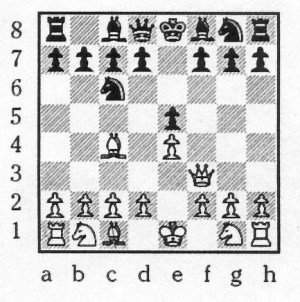
Second, try to develop your plan. For example, it makes no sense to just put "check" just to proudly pronounce this word if the opponent can easily defend against your single attack. But if you start attacking the enemy king with several pieces of your "army" at once, then this will have a much greater effect.
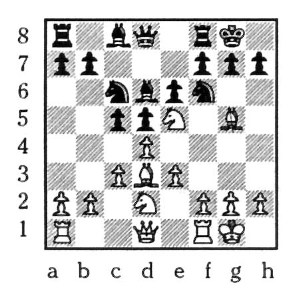
Third, know the value of each piece. It is foolish to "eat" someone else's pawn in order to immediately lose your queen. When exchanging pieces, take into account their conditional price: a knight and a bishop cost about three pawns, a rook - six, a queen - nine. The king, as you know, is priceless.
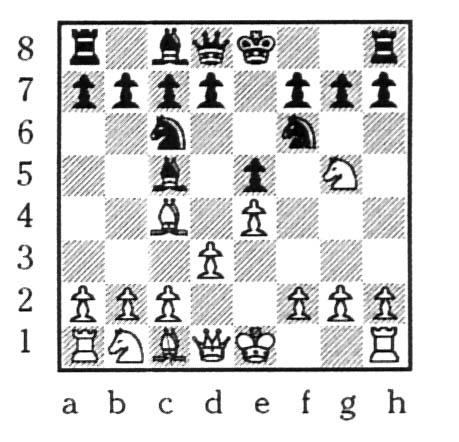
Fourth, try to control the center of the board, at least the central four squares. The pieces in the corners and on the edges are less agile, they are less involved in the game. That is why, by the way, do not delay the introduction of significant pieces into the game - you cannot win the initiative with pawns alone!
Fifth, remember that "double" pawns (that is, standing on the same line after you "ate" an opponent's piece with one of them) cannot defend each other. This is especially important at the end of the game.
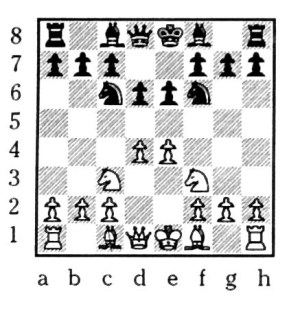
Sixth, always think about the safety of the king! No matter how confident the position of your pieces on the board looks, all this will be useless if your king is under attack and cannot avoid it.
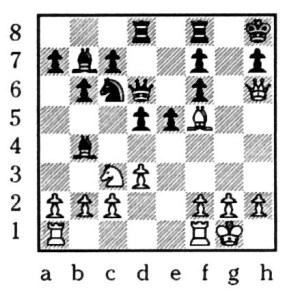
And most importantly - have fun!
